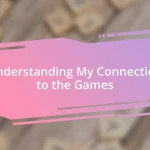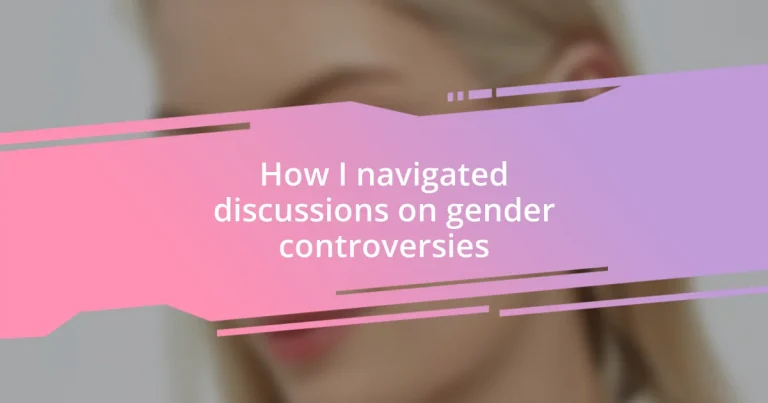Key takeaways:
- Understanding gender controversies requires empathy, open-mindedness, and awareness of personal biases and societal influences.
- Effective communication strategies, such as using “I” statements and active listening, foster respectful and constructive dialogues about gender issues.
- Evaluating discussions and seeking feedback reveals insights and promotes personal growth, emphasizing the importance of emotional connections in conversations.
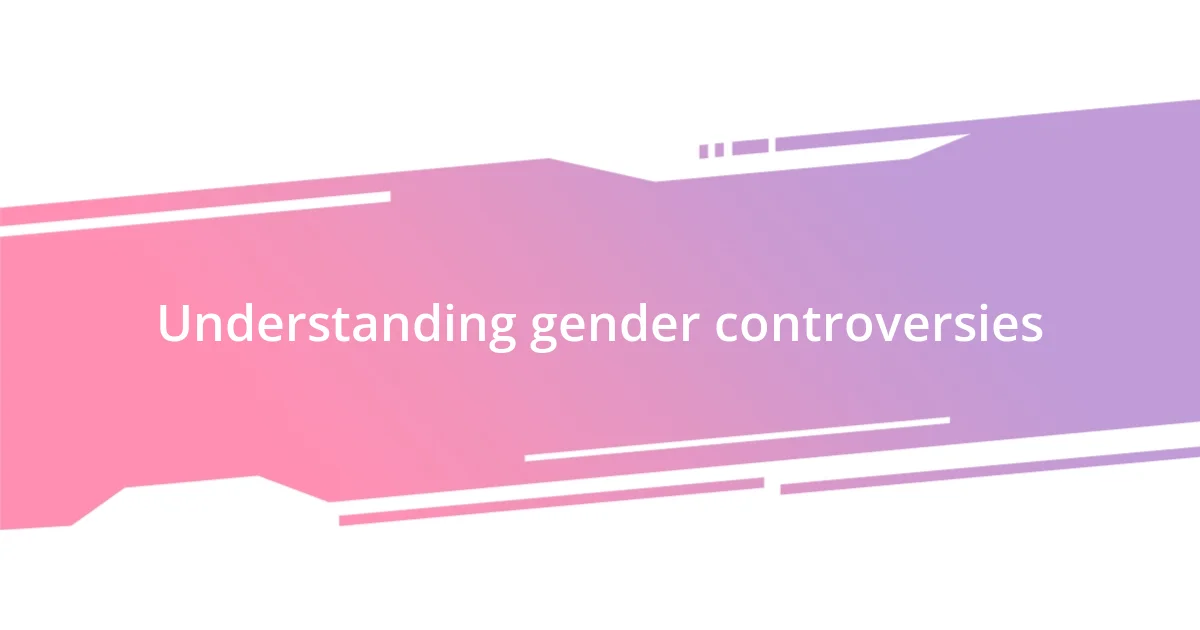
Understanding gender controversies
Understanding gender controversies often requires us to peel back layers of history, culture, and individual experiences. I remember attending a community event where the topic sparked a heated debate. It struck me how deeply personal and yet universally relevant these discussions are; everyone brought their own stories and feelings to the table, revealing how closely tied identity is to our societal framework.
As I delved deeper into these issues, I often found myself asking, “What does it mean to belong?” This question emerged during a conversation with a close friend who identified as non-binary. Their candid sharing of experiences highlighted how societal norms can create barriers that make it difficult for individuals to express their true selves—an emotional journey that many others have faced as well.
Moreover, I realized that understanding these controversies requires empathy and an openness to different perspectives. Encountering viewpoints that differ from mine can be uncomfortable, but it’s in that discomfort where growth happens. Reflecting on moments in my life when I’ve felt misunderstood, I see parallels in others navigating their gender identities. It’s a reminder that at the core of these discussions are real lives and experiences waiting to be acknowledged.
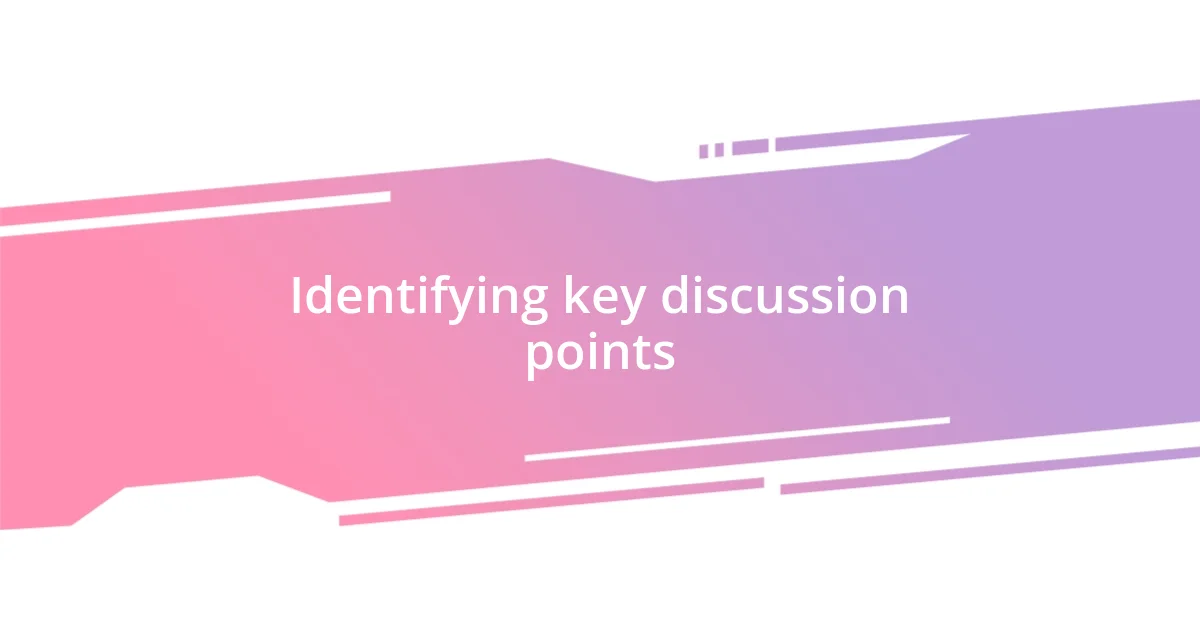
Identifying key discussion points
Identifying key discussion points in gender controversies often starts with understanding the language we use. For instance, when I first encountered terms like “cisgender” and “gender fluid,” I felt somewhat lost. Recognizing the importance of these definitions was crucial; they shape how we communicate and frame discussions, opening doors to a more inclusive dialogue where everyone can contribute meaningfully.
In my experience, it’s also vital to acknowledge the intersectionality of these issues. I recall a panel discussion I attended where speakers from diverse backgrounds shared how race, class, and geographical location influenced their gender experiences. This was an eye-opening moment for me. It became clear that discussions can’t merely focus on gender alone; instead, we must consider the broader context in which these identities exist, highlighting the multifaceted nature of personal experiences.
Finally, I’ve learned that listening is just as important as speaking. During a workshop, I practiced active listening techniques that allowed me to hear—not just listen—to others’ stories. Seeing the relief on participants’ faces after sharing their experiences reinforced for me the value of creating spaces where everyone feels safe and heard. It’s a reminder that every discussion point should center on fostering connections and understanding amongst individuals.
| Discussion Point | Description |
|---|---|
| Language | Understanding terms like cisgender and gender fluid is crucial for inclusive dialogue. |
| Intersectionality | Considering race, class, and geographical influences enriches the discussions. |
| Active Listening | Listening allows space for shared experiences, creating connection and understanding. |
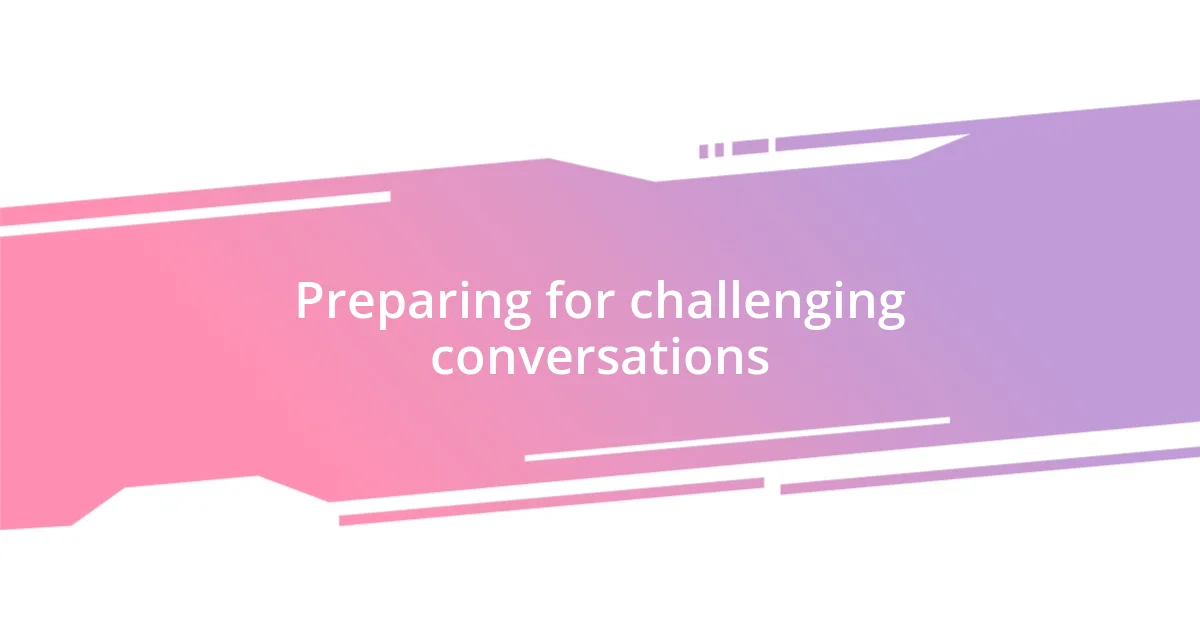
Preparing for challenging conversations
Preparing for challenging conversations requires a mindset shift. I’ve found it essential to approach these discussions with curiosity rather than judgment. One strategy that has worked for me is taking a step back and setting my emotional state before engaging. For example, I remember a time when I felt overwhelmed before addressing my concerns about gender identities at a family gathering. By grounding myself with deep breaths and reminding myself that everyone’s experiences are valid, I was able to foster a more open and productive dialogue.
Here’s a quick rundown of helpful strategies to consider:
-
Self-Reflection: Before speaking, reflect on your biases and experiences. This step helps you become aware of what you bring to the conversation.
-
Set Intentions: Clearly define what you hope to achieve. Whether your aim is to educate, understand, or simply listen, having a goal can guide the flow of discussion.
-
Create Safe Spaces: Encourage an environment where people feel comfortable sharing their thoughts. I remember implementing this during a group discussion, where I requested everyone to share without interruption.
-
Be Prepared for Discomfort: Accept that these conversations might be tough. Embracing discomfort shows personal growth and invites others to explore their feelings as well.
By preparing in these ways, I’ve noticed the conversations become more enriching, allowing for a greater understanding of the diverse experiences surrounding gender.
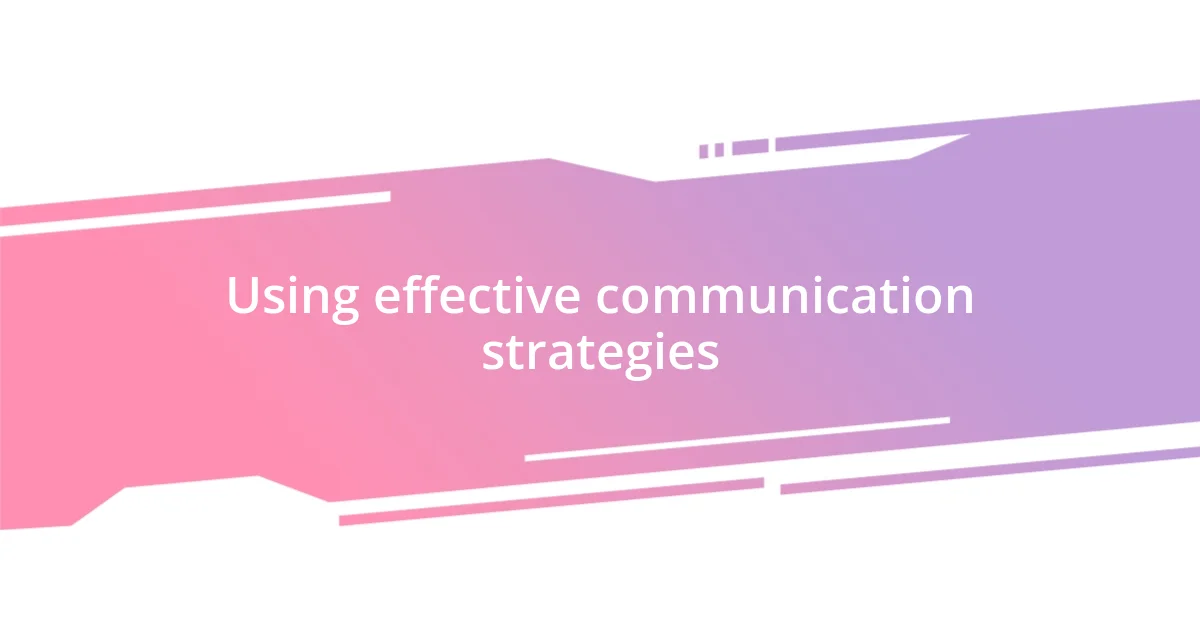
Using effective communication strategies
Effective communication strategies are essential when navigating discussions on gender controversies. I often find that using “I” statements makes a significant difference. For instance, instead of saying, “You are wrong about gender,” I approach the conversation with, “I feel that understanding gender as a spectrum opens up more inclusive discussions.” This subtle shift invites collaboration rather than confrontation, allowing others to see my perspective without feeling attacked. Have you ever noticed how language can change the tone of an entire conversation?
Another strategy I recommend is to remain open to feedback. During a recent discussion at my workplace, I shared my views on gender inclusivity, and one colleague offered a different perspective that challenged my thoughts. Initially, I felt defensive, but I reminded myself to listen openly. Embracing this feedback not only enriched my understanding but also demonstrated to my colleagues that I value their input. It’s amazing how this openness fosters a deeper connection and encourages others to share openly, don’t you think?
Finally, I focus on non-verbal cues, as they can be just as powerful as words. When engaging in discussions about gender, I make a conscious effort to maintain eye contact and use affirmative nods. I recall a time when a friend spoke about her struggles with identity; my supportive presence helped her feel validated. It reinforced the idea that effective communication goes beyond just words—it’s about creating an atmosphere where everyone feels valued and understood. How do you express support in your conversations?
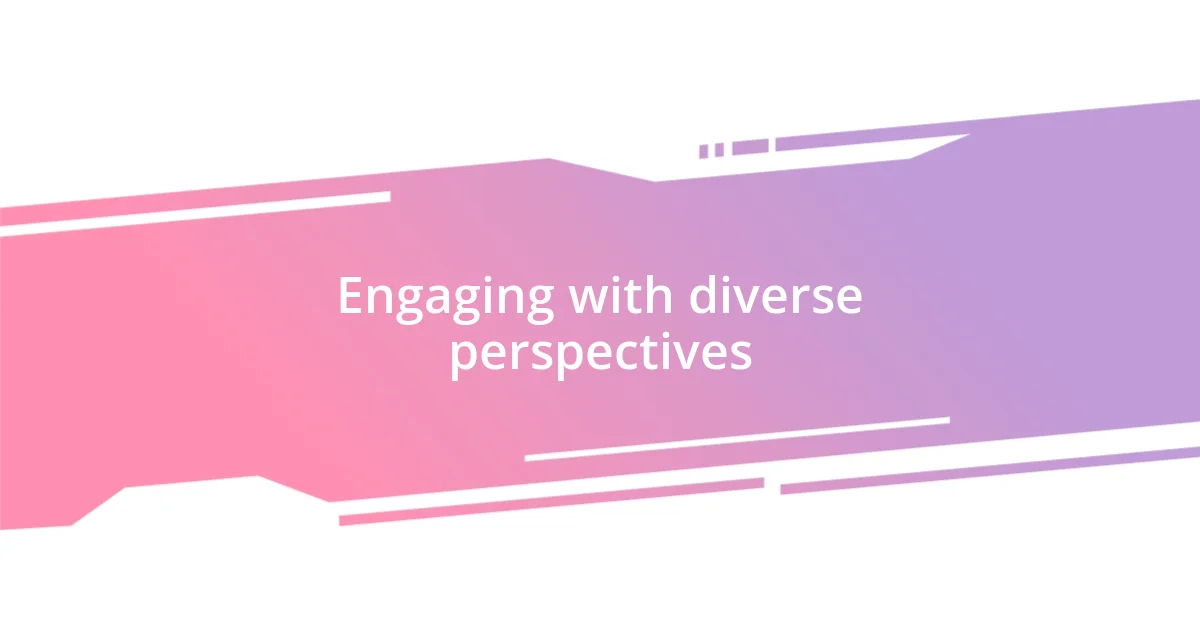
Engaging with diverse perspectives
Engaging with diverse perspectives is crucial in discussions about gender controversies. I’ve found that asking open-ended questions can be a powerful way to encourage others to share their views. For instance, during a recent dialogue with a friend who holds different beliefs, I asked, “What experiences have shaped your understanding of gender?” This not only created a space for her thoughts but also allowed me to reflect on my own biases. It’s fascinating how peeling back layers can reveal the complexities of our perspectives, isn’t it?
When I actively listen to differing opinions, I notice a shift in my understanding. There was a moment in a community meeting where someone passionately spoke about their experiences related to gender fluidity, which challenged the traditional views I held. As I leaned into my discomfort and listened intently, I felt my preconceived notions start to waver. Have you ever felt that rush of enlightenment when you consider someone else’s experience? For me, those moments are transformative—they help bridge gaps and cultivate empathy.
Creating a culture of respect is essential in these conversations. I once participated in a panel discussion where each participant was encouraged to share a personal story related to their gender identity. This collective sharing drew us closer together, allowing us to see the human side of each narrative. I realized that while our views might differ, the underlying emotions and experiences often connect us in unexpected ways. How often do we let stories guide our understanding instead of allowing biases to dictate our responses?

Managing emotions and reactions
Navigating emotions during discussions about gender can be particularly challenging, and I often find myself experiencing a whirlwind of feelings. For example, I vividly remember a time when a heated debate arose during a family gathering about gender roles. I felt my heart racing and my palms getting sweaty, but I took a deep breath and reminded myself to stay calm. By acknowledging my emotions, I could respond thoughtfully rather than react impulsively, which ultimately preserved the conversation’s constructive nature.
When confronted with strong reactions from others, my approach hinges on empathy. During a workshop on gender sensitivity, a participant became visibly upset while sharing her story about discrimination. I sensed her pain and decided to validate her feelings by saying, “It’s completely understandable to feel this way, given your experiences.” Sharing that moment allowed us to connect on a deeper level, transforming tension into a space of shared understanding. Isn’t it astonishing how acknowledging someone’s feelings can turn the tide of a discussion?
Moreover, I make it a point to check in with myself throughout these conversations. One evening, while discussing non-binary identities with friends, I realized I was getting increasingly frustrated by their misconceptions. Rather than shutting down, I paused to ask myself why I felt triggered. This self-reflection helped me articulate my thoughts more clearly, resulting in a dialogue that was not just informative but genuinely engaging. Have you ever taken a moment to reflect on your feelings during a tough conversation? It can be a game changer in promoting healthier discussions.
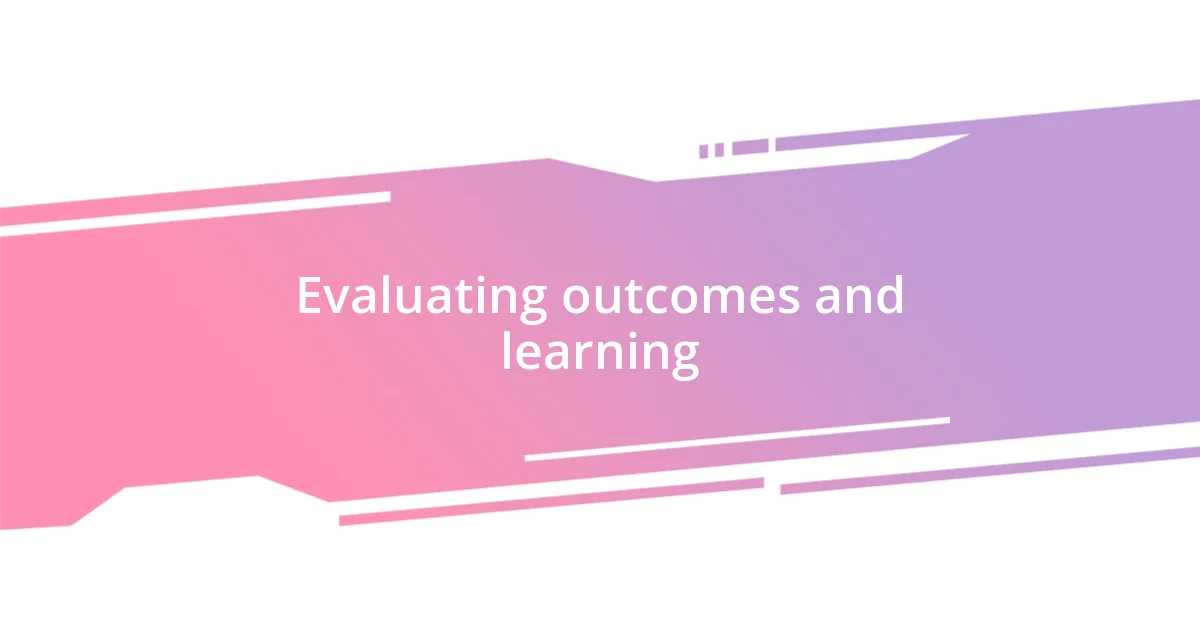
Evaluating outcomes and learning
Evaluating the outcomes of my discussions on gender issues has often revealed unexpected insights. Once, after engaging in a thoughtful debate with colleagues about the impact of gender stereotypes in media, I took a step back to assess our dialogue. I realized that, though our opinions varied widely, the conversation sparked genuine curiosity in many of us, prompting further research and discussions beyond that initial meeting. Isn’t it incredible how one conversation can inspire a ripple effect of exploration?
One of the most powerful lessons I’ve learned involves recognizing the importance of feedback. After a community event focused on gender inclusivity, I asked attendees for their thoughts on the discussion format. Their responses were enlightening; several shared that they felt more empowered to express their viewpoints because of the open environment we fostered. This taught me that creating space for others to evaluate their experiences can lead to unexpected personal growth for everyone involved. Have you ever sought feedback to enrich a dialogue? It’s truly eye-opening.
Additionally, reflecting on the emotional responses generated during these conversations has been transformative for my learning journey. During a discussion surrounding gender identity in a classroom setting, I noticed how vulnerability sparked deeper connections among my peers. I recalled sharing my own struggles with understanding gender nuances, which helped others to feel safe enough to share their stories. This led me to appreciate that the evaluation of outcomes isn’t just about intellectual understanding but also about the emotional bonds we form. How often do we underestimate the power of vulnerability in fostering genuine discussion?











